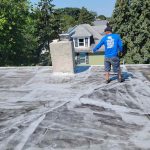As the vibrant colors of autumn sweep across New Jersey, many homeowners are reminded of the beauty and challenges that fall brings. While the sight of leaves changing color is undeniably charming, the aftermath of those leaves landing on your roof can pose significant risks. Falling leaves, twigs, and other debris can accumulate on your roof, leading to a host of problems that could compromise the integrity of your roofing system. To keep your roof in top shape during the fall season, it’s crucial to take proactive steps to protect it from the buildup of leaves and debris. In this blog, Super Duty Roofing offers expert advice on how to safeguard your roof from autumn’s hazards.
Why Falling Leaves and Debris Are a Problem
While a few leaves on your roof may seem harmless, the reality is that they can cause serious issues if left unchecked. Here’s why:
- Moisture Retention: When leaves accumulate on your roof, they can trap moisture. This prolonged exposure to moisture can lead to the growth of mold, mildew, and algae, which can deteriorate roofing materials over time.
- Clogged Gutters: Leaves and debris can easily find their way into your gutters, causing clogs that prevent proper water drainage. When gutters are blocked, water can back up onto the roof, leading to leaks, water damage, and even structural problems.
- Added Weight: A thick layer of wet leaves can add unnecessary weight to your roof, which could strain the roofing materials and support structures. Over time, this additional weight can cause sagging or other structural issues.
- Pest Attraction: Piles of leaves on your roof can attract pests such as rodents, insects, and birds. These animals may create nests in the debris, further damaging your roof and potentially entering your home.
Steps to Protect Your Roof from Falling Leaves and Debris
To prevent these problems and extend the life of your roof, follow these essential steps:
1. Regular Roof Inspection
Begin by conducting a thorough inspection of your roof. Look for any signs of damage, such as missing or cracked shingles, loose flashing, or sagging areas. If you’re not comfortable inspecting the roof yourself, consider hiring a professional roofing contractor to do it for you. Identifying and addressing any existing issues before the leaves start to fall will ensure your roof is in the best condition to handle the additional stress.
2. Clean Your Gutters and Downspouts
Gutters and downspouts are critical components of your home’s drainage system, directing water away from the roof and foundation. Before the leaves begin to fall, clean out any existing debris from your gutters and downspouts. This will prevent clogs and ensure that rainwater can flow freely. Consider installing gutter guards to minimize the amount of debris that can enter your gutters and reduce the need for frequent cleaning.
3. Trim Overhanging Branches
Trees that hang over your roof are a primary source of falling leaves and debris. Trim back any overhanging branches to reduce the amount of material that lands on your roof. This will also help prevent branches from rubbing against the shingles during windy weather, which can cause damage. Trimming branches can also reduce the risk of larger limbs breaking off and falling onto your roof during storms.
4. Rake Leaves Off the Roof
If you notice that leaves are beginning to accumulate on your roof, use a roof rake or a soft-bristled broom to gently remove them. Be cautious when working on the roof, and avoid using a metal rake or other tools that could damage the shingles. If you’re uncomfortable working at height, consider hiring a professional to do the job safely.
5. Install Roof Ventilation
Proper roof ventilation can help reduce the risk of moisture buildup caused by trapped leaves and debris. Ensure that your attic is well-ventilated to allow air to circulate, keeping the roof dry and reducing the chances of mold and mildew growth. Installing ridge vents, soffit vents, or other ventilation systems can help maintain the health of your roof during the fall season.
6. Schedule Professional Roof Maintenance
Regular professional roof maintenance is one of the best ways to protect your roof from the effects of falling leaves and debris. A roofing expert can perform a thorough inspection, clean the roof, and address any minor issues before they become major problems. Scheduling maintenance before and after the fall season can help ensure your roof remains in excellent condition year-round.
Conclusion
Autumn is a beautiful time of year, but it also presents unique challenges for homeowners in New Jersey. Falling leaves and debris can cause significant damage to your roof if not properly managed. By taking proactive steps such as regular inspections, cleaning gutters, trimming branches, and scheduling professional maintenance, you can protect your roof from the hazards of the season. At Super Duty Roofing, we’re here to help you keep your roof in top shape, no matter the season. Contact us today for expert advice and services to ensure your home stays protected throughout the year.




















